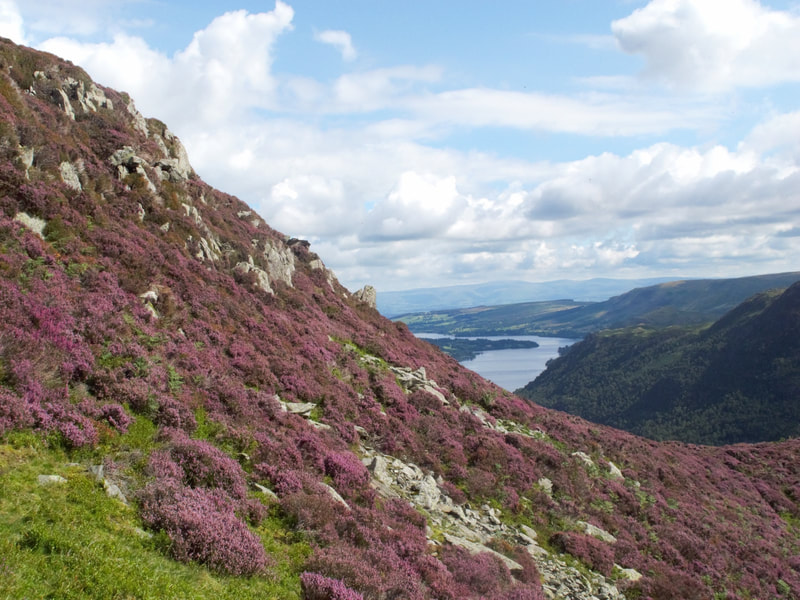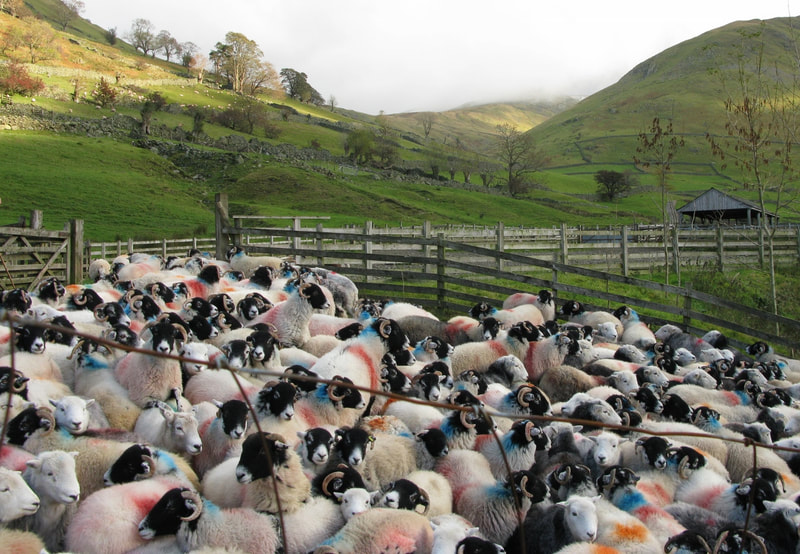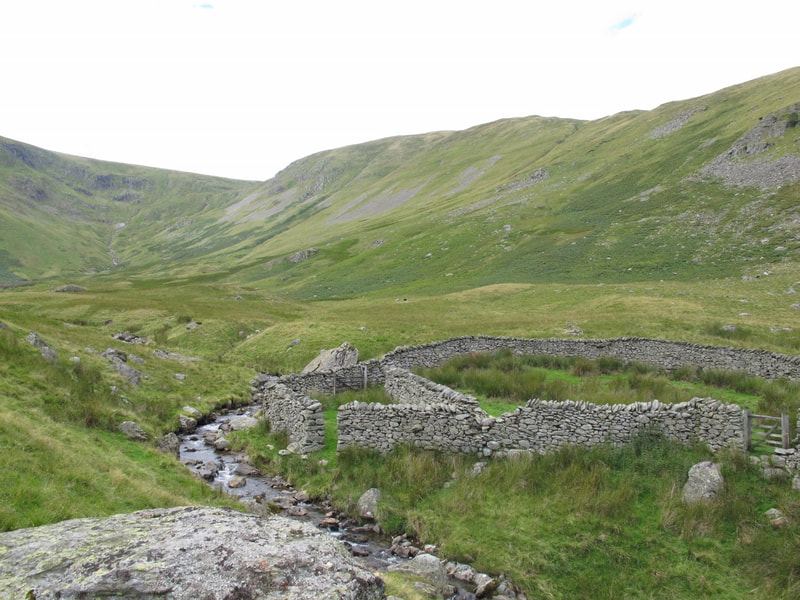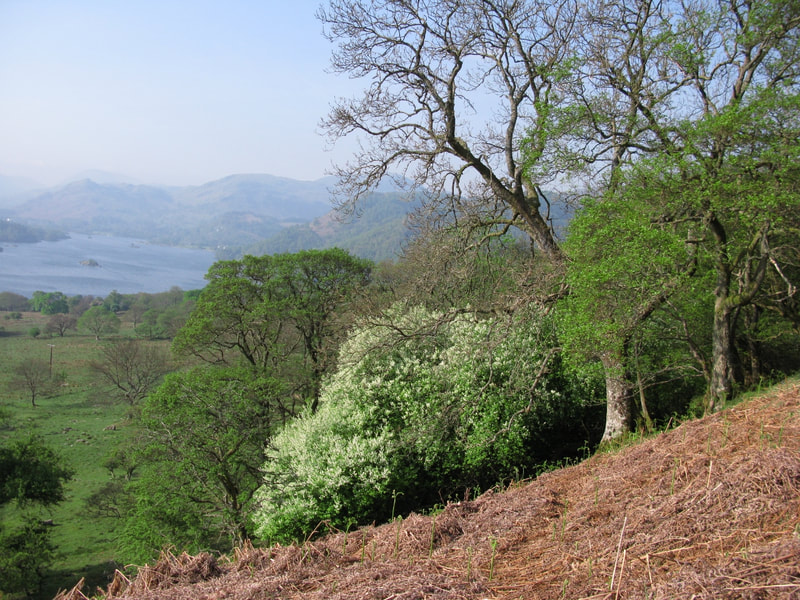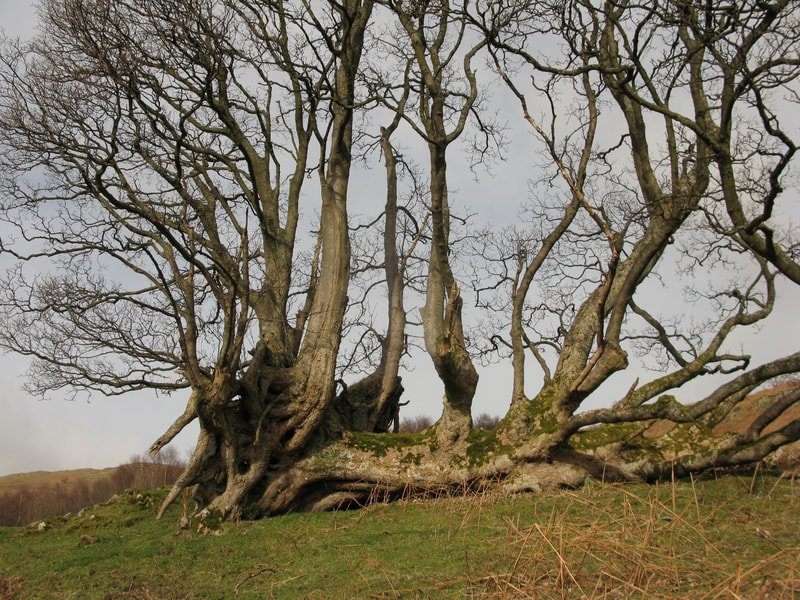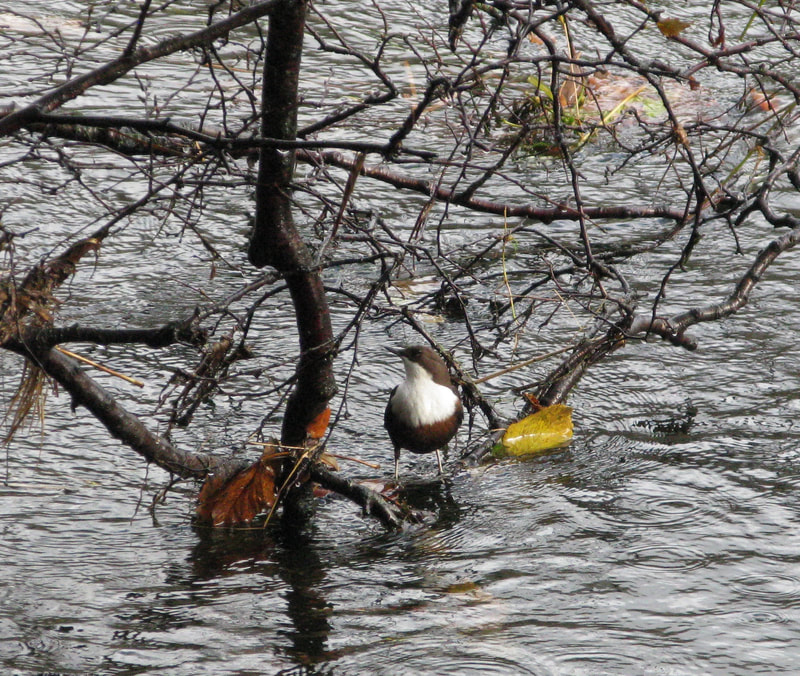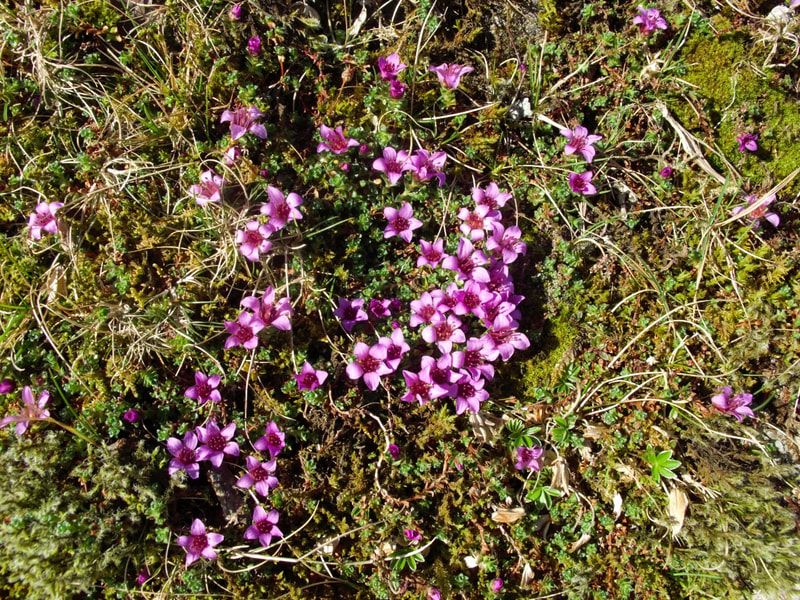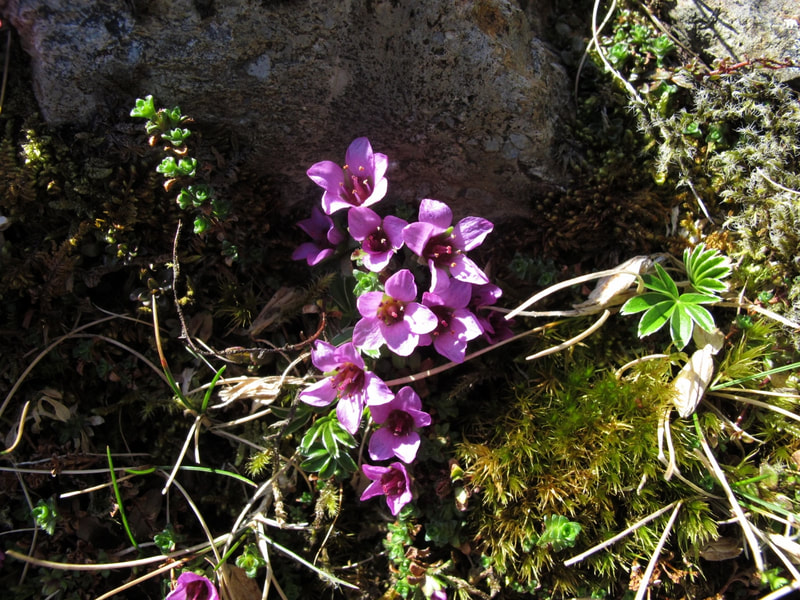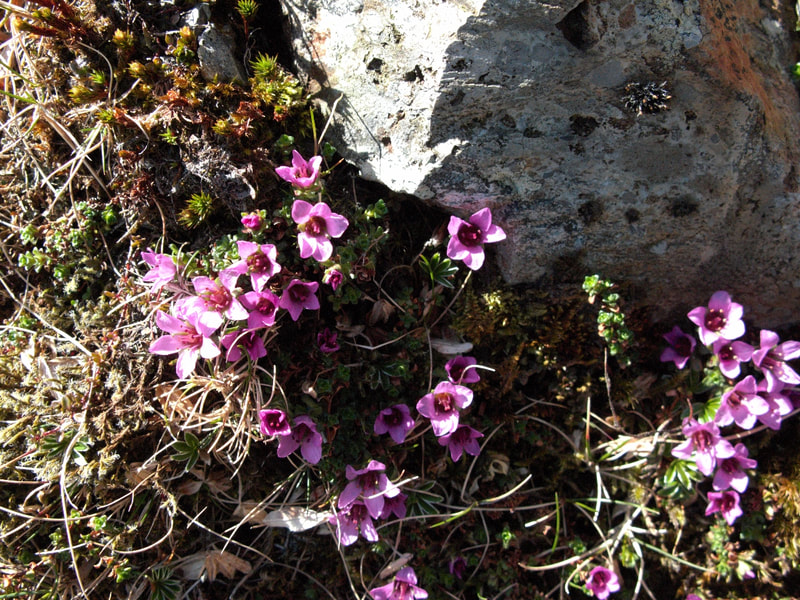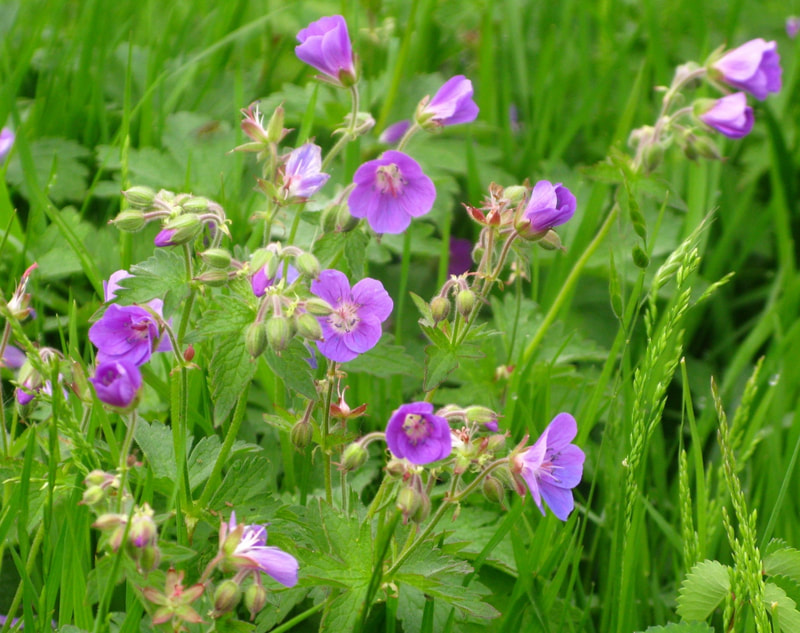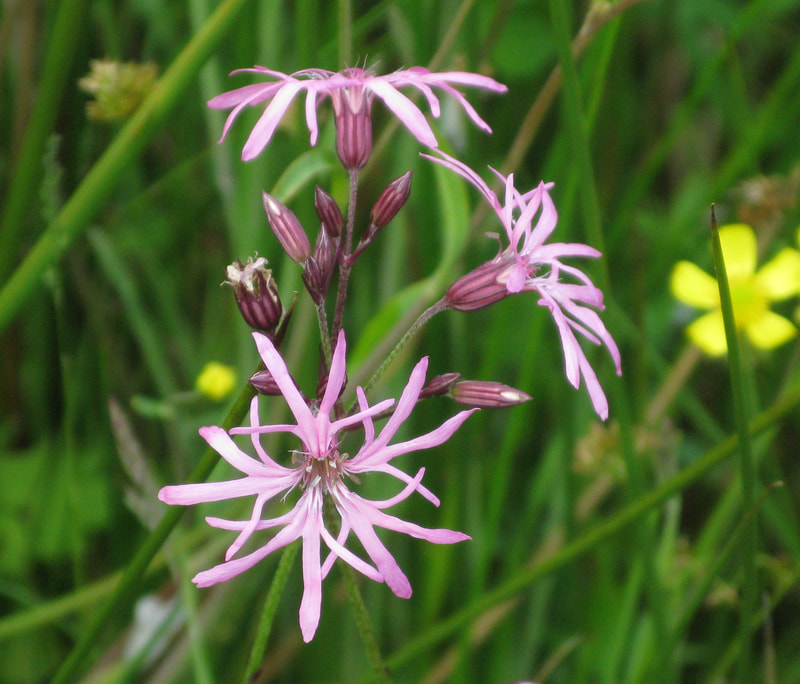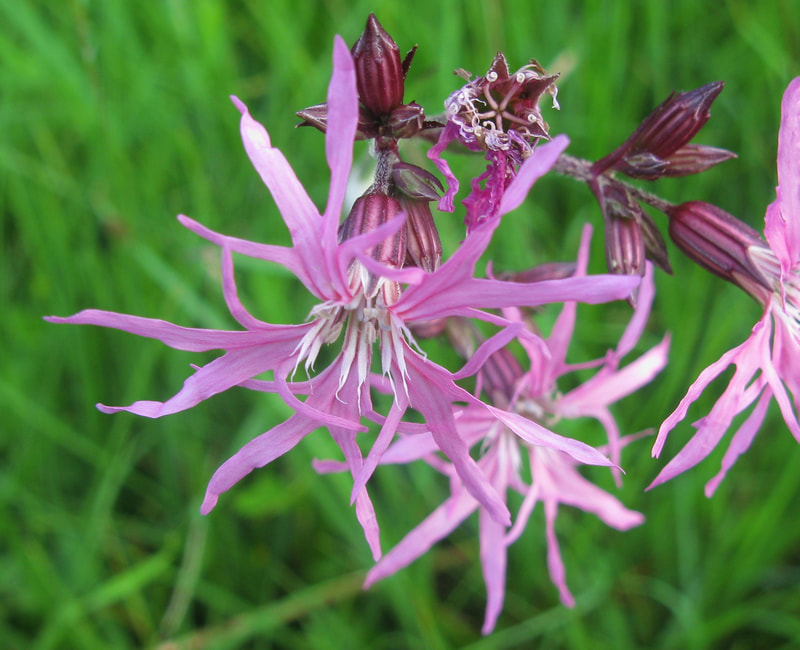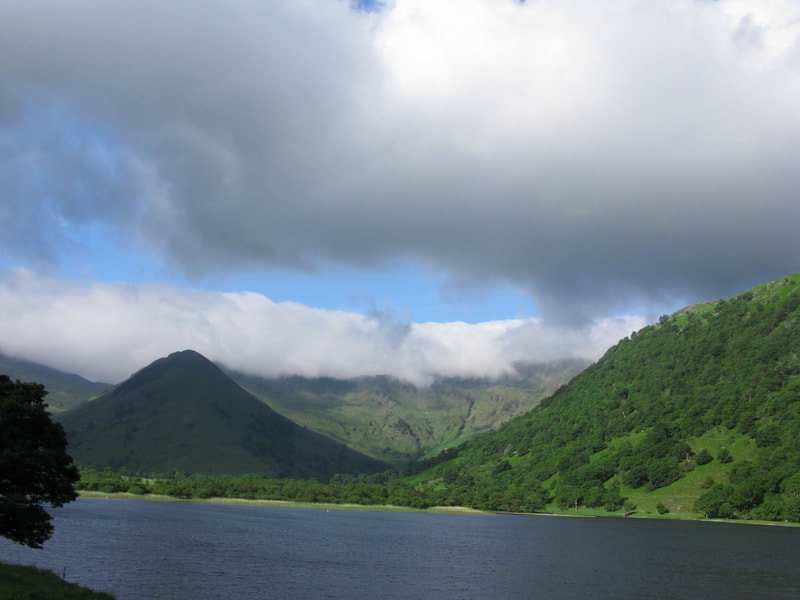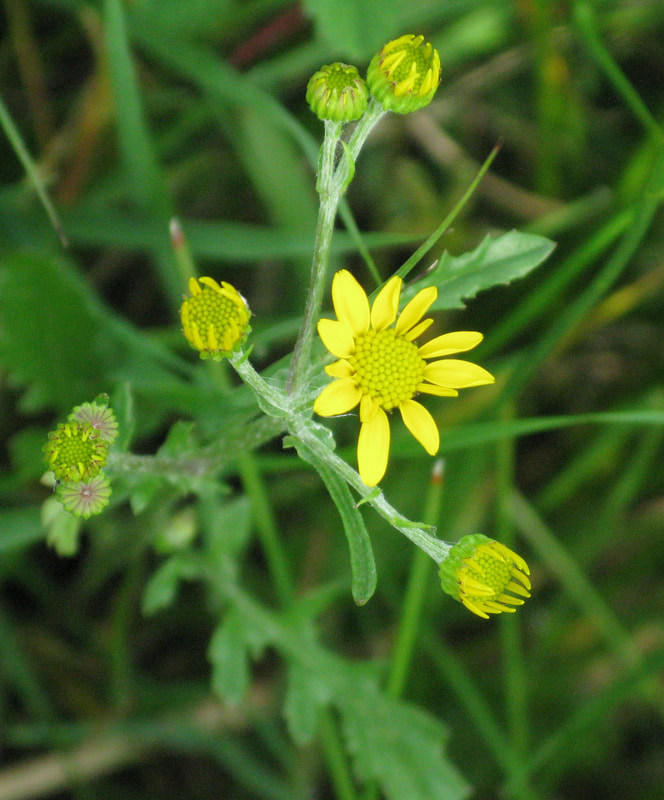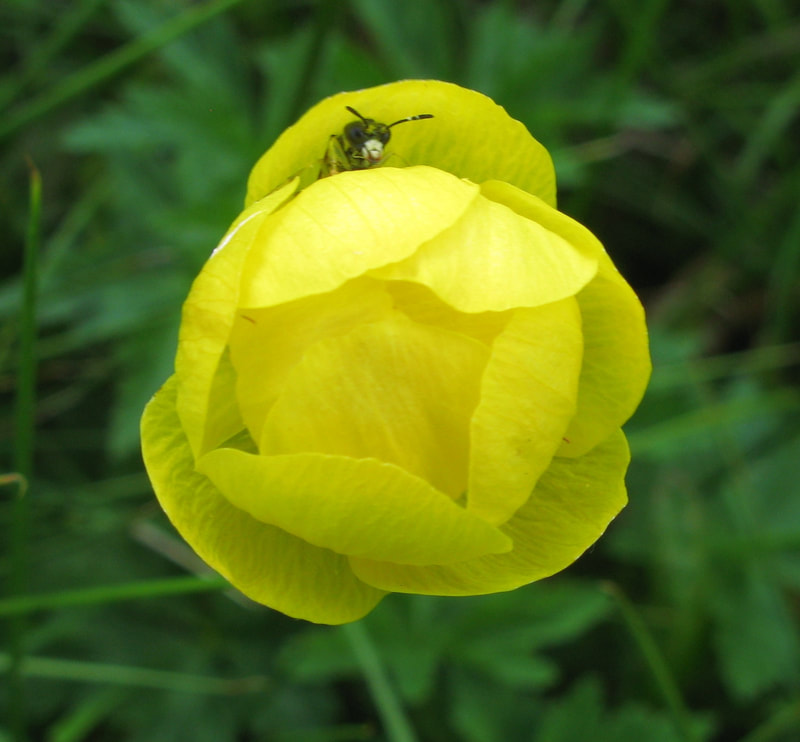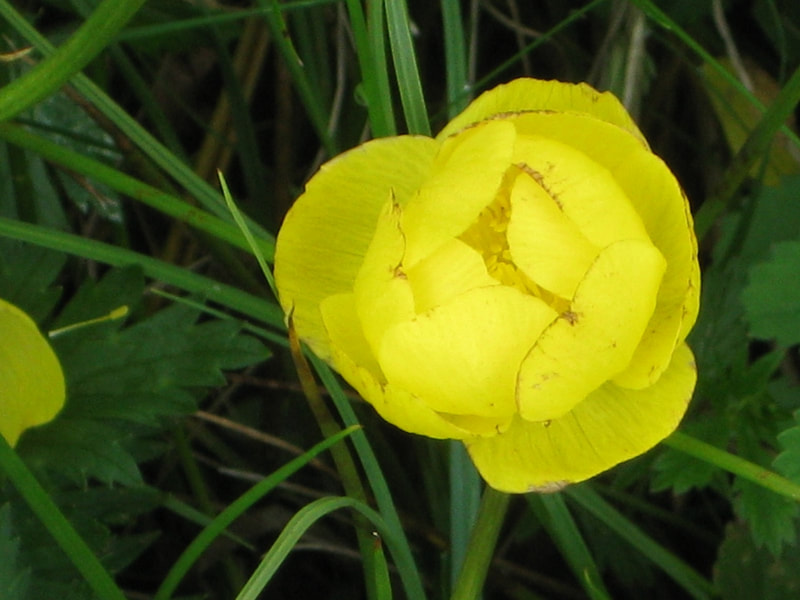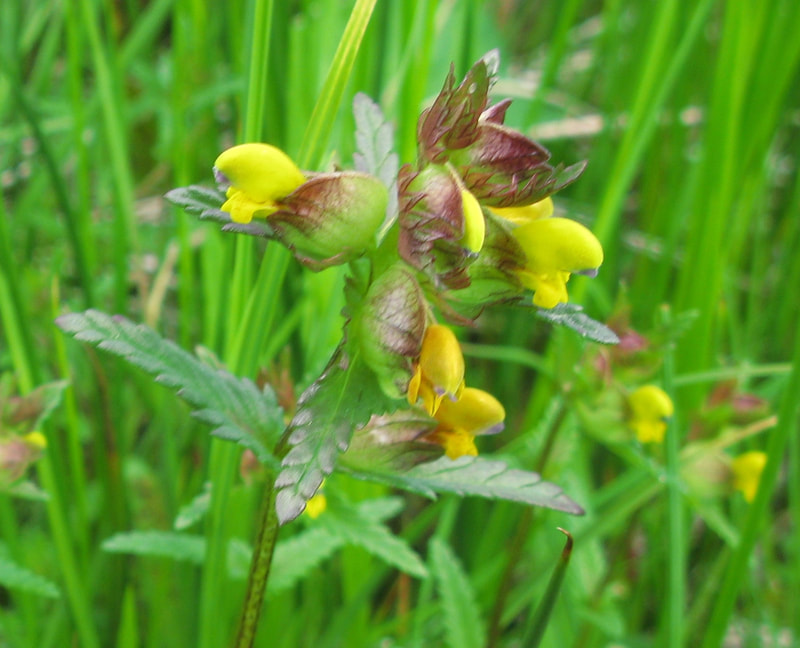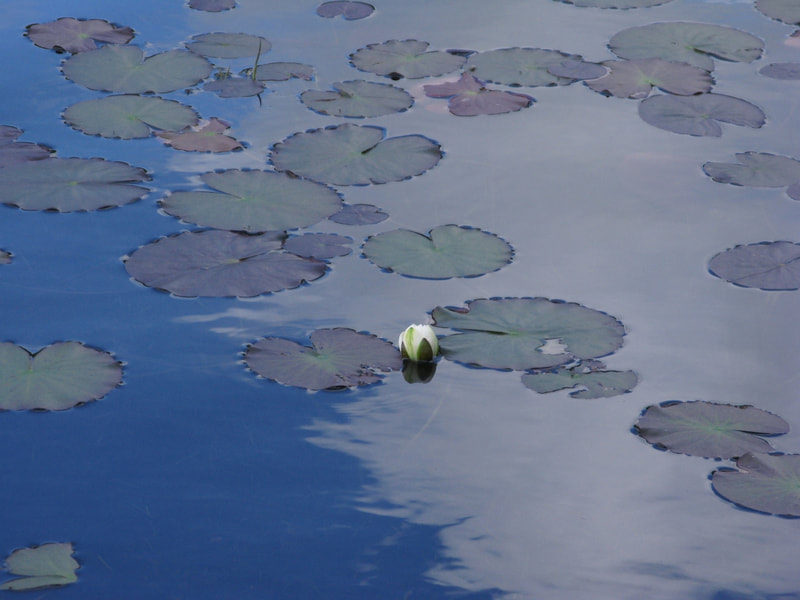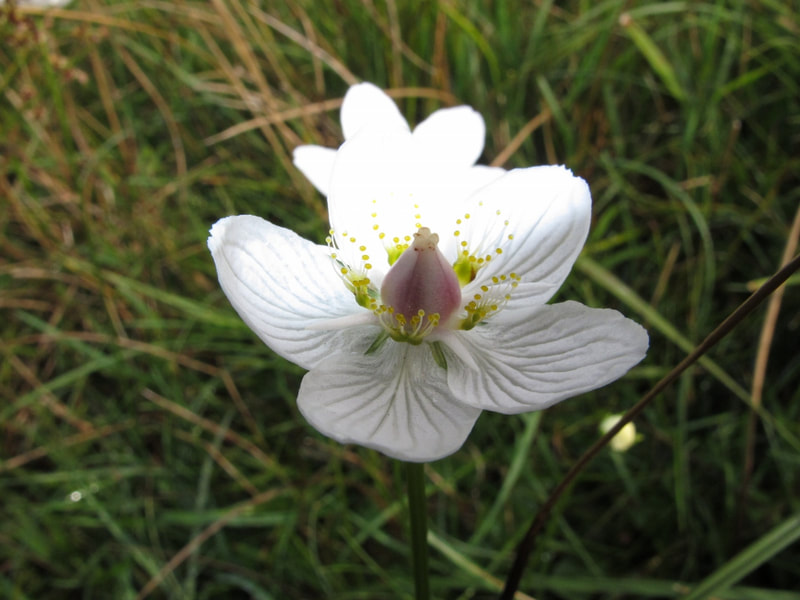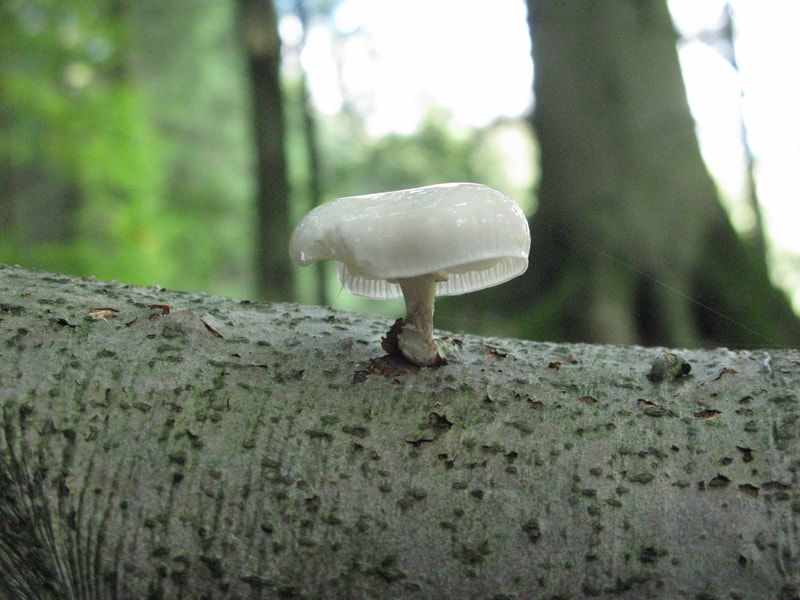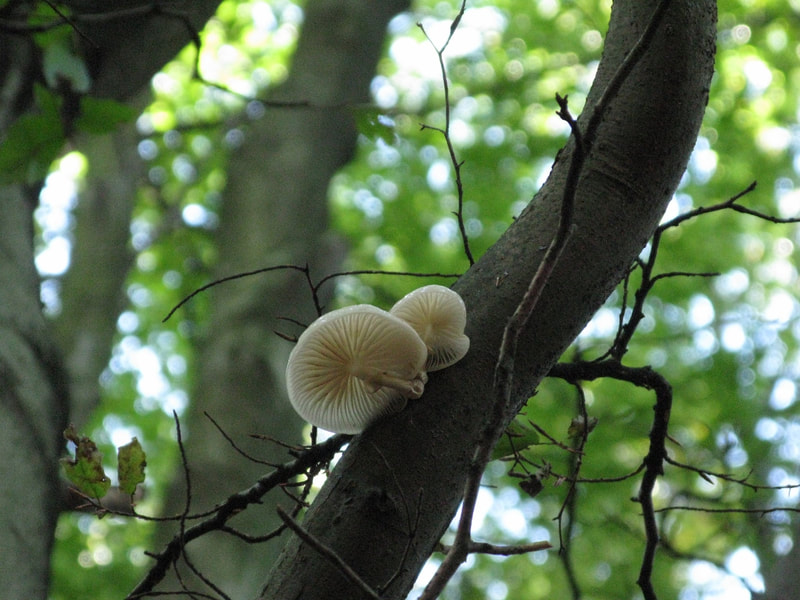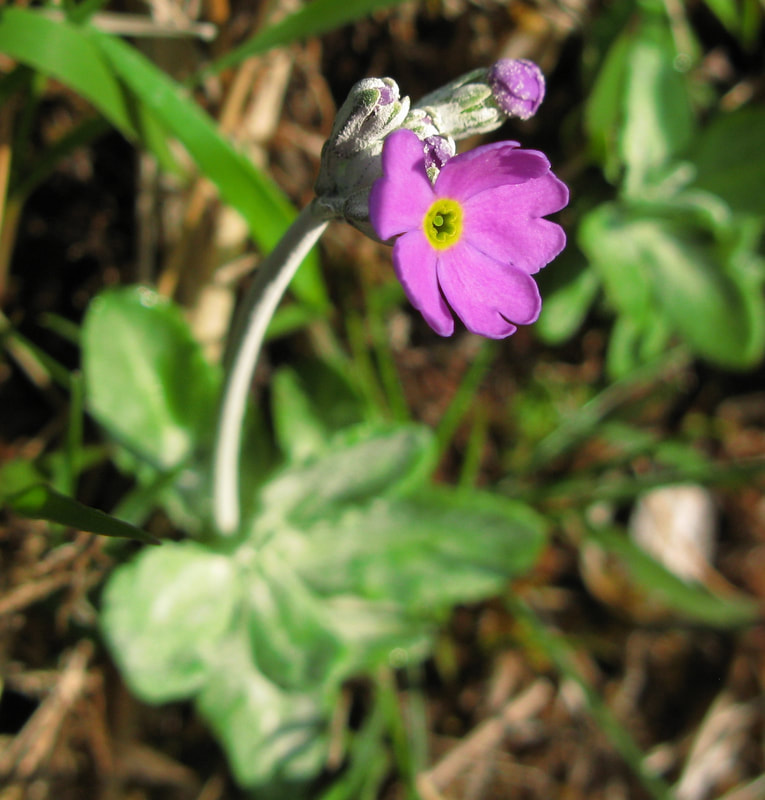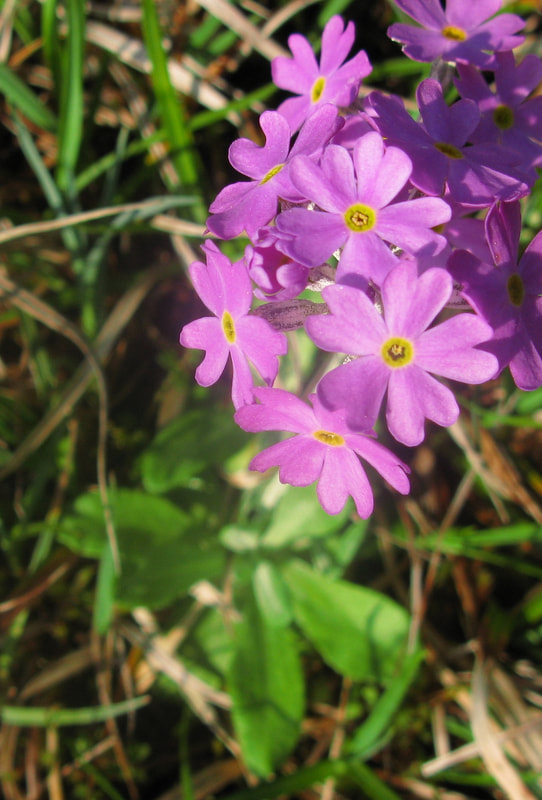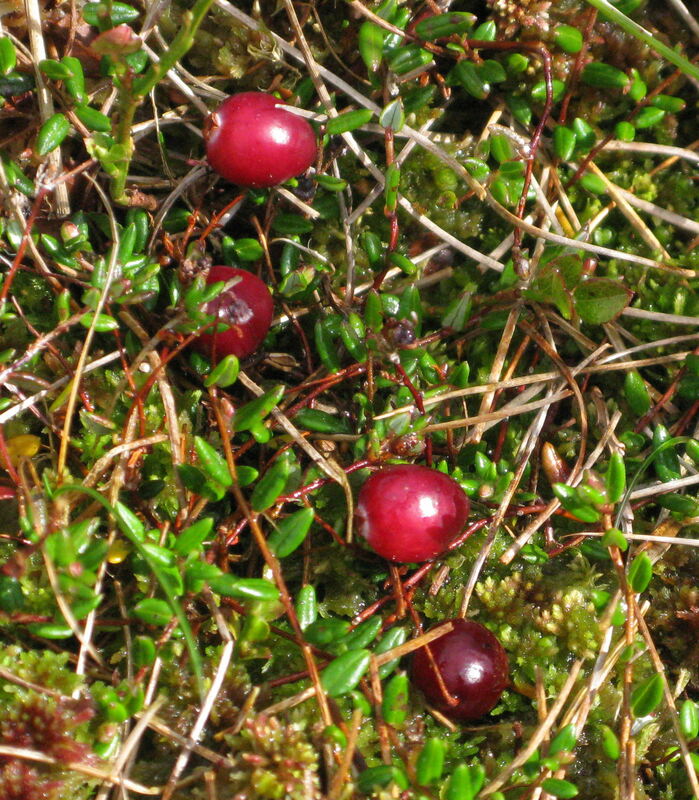Ullswater
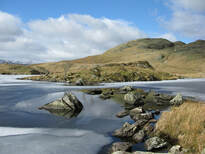 Angle Tarn under ice 14th March 2010
Angle Tarn under ice 14th March 2010
Prelude
Cloud hung low over the Kirkstone Pass with water pouring off the fells down into Brothers Water and Patterdale. Walkers on the Coast to Coast route came off High Street, seeking respite from wind and rain. Thank heavens for the historic barns of Hartsop where we sheltered from successive downpours during our farm walk, taking in vernacular architecture, hearing of the history of farming in the dale. Late summer flowers spilled down beside the beck and farmer Alan Wear told of his northern hay meadow, rare habitat on the shore of Brothers Water. He spoke of the glories of Waterend meadow through spring and summer: of flowers, butterflies, dragonflies and damselflies, and of water birds. On his invitation, I would return in the spring to follow the season-sequence in these Sites of Special Scientific Interest. Striding out from Hartsop and heading for the heights, for years I had overlooked the wildlife highlights I was soon to discover. Fell and dale, I tell myself.
Hill farming and conservation go hand in hand for Sam and Candida Hodgson of Glencoyne, a 17th century farmhouse and one of the most extensive National Trust farms in the Lakes. They cherish the red grouse and regenerated heather habitat they manage up on Gowbarrow Fell. From alder carr along the becks running off Gowbarrow to the waterfalls of Aira Force, through the parkland habitat of Glencoyne and up onto the blanket bog of the watershed and the source of Little Aira Beck- I love to delve different habitat.
Solitude and rarities come together in the eastern corries of Helvellyn, with some of the last of the montane flora of the Lake District. High-ledge plant communities, often inaccessible. It’s the best protection for wildlife.
Cloud hung low over the Kirkstone Pass with water pouring off the fells down into Brothers Water and Patterdale. Walkers on the Coast to Coast route came off High Street, seeking respite from wind and rain. Thank heavens for the historic barns of Hartsop where we sheltered from successive downpours during our farm walk, taking in vernacular architecture, hearing of the history of farming in the dale. Late summer flowers spilled down beside the beck and farmer Alan Wear told of his northern hay meadow, rare habitat on the shore of Brothers Water. He spoke of the glories of Waterend meadow through spring and summer: of flowers, butterflies, dragonflies and damselflies, and of water birds. On his invitation, I would return in the spring to follow the season-sequence in these Sites of Special Scientific Interest. Striding out from Hartsop and heading for the heights, for years I had overlooked the wildlife highlights I was soon to discover. Fell and dale, I tell myself.
Hill farming and conservation go hand in hand for Sam and Candida Hodgson of Glencoyne, a 17th century farmhouse and one of the most extensive National Trust farms in the Lakes. They cherish the red grouse and regenerated heather habitat they manage up on Gowbarrow Fell. From alder carr along the becks running off Gowbarrow to the waterfalls of Aira Force, through the parkland habitat of Glencoyne and up onto the blanket bog of the watershed and the source of Little Aira Beck- I love to delve different habitat.
Solitude and rarities come together in the eastern corries of Helvellyn, with some of the last of the montane flora of the Lake District. High-ledge plant communities, often inaccessible. It’s the best protection for wildlife.
10 August 2008 Cross Gates Farm Walk,Hartsop
There had been days and days of unsettled weather and a farm walk in the dale would give some shelter from strong winds and lashing rain.
Now in his sixties, Alan Wear grew up in Hartsop and has farmed in the dale all his life. As a boy, he set himself to find a hundred nests in a season. He attributed the dramatic decline in cuckoos over the last thirty years to a badger population whose numbers were out of control. Not the first farmer to tell of badgers hoovering up the eggs and chicks of ground nesting birds- potential foster parents of the cuckoo. Pied wagtails nesting in a dry stone wall were tumbled from their niche by a badger pulling at the stones to get at the chicks. He found a rogue badger, an old creature with a single tooth, dead in his hogget house. It had killed several lambs, ripping out heart and lungs.
Until some 50-100 years ago ash and holly were cropped to provide fodder for animals and old trees often grow close to farmsteads, as they do here. The word ‘hollins’ on OS maps locates them. Ash pollards can be striking natural sculptures with their scarred and hollowed-out trunks and with new branches sprouting like the shock of hair of a cartoon character. Pollarding prolongs the life of a tree, so the ancient ash pollards of Cumbria are of interest to ecologists. They are no longer needed for fodder but if new branches overweight the canopy the National Trust cuts them back.
A snapshot of Hartsop at different periods in history would show how life in the dale is always changing. Down in the intersection between Hayeswater Gill and Pasture Beck is a disused lead mine, with adits on the flank of Hartsop Dodd and a slate quarry. Arable crops were once grown in Patterdale, with a ruined corn mill and a Hartsop building where corn was dried over a stone-slatted roof with fire below. Each change in agriculture results in a change of use for these vernacular buildings. An old two-storey farm house, under conservation, has a huge fire place where bacon might dry, a flag floor, walls with a white layer of lime plaster and horse hair. We took shelter from another downpour in a stone building with straw-covered floor and with hooks on beams from a time when cattle were slaughtered on the farm.
Hartsop Dodd rises to 618 metres and with high rainfall and poor grazing only sheep bred for the fells can cope with exposure at that altitude. The native Herdwick is robust and its dense fleece dries out quickly. The Swaledale has a strong constitution, and the ewe makes a good mother. Alan’s hill sheep are thoroughbreds, with income from the sale of blood stock.
New-born waterfalls cascaded off the fells, water gleamed on rock. Throughout the afternoon, fitful beams of sunlight streaked the fells and contested with louring cloud and downpours and a rainbow arced over the valley. A kestrel hovered over the in-bye land, with its ancient field boundaries and dry stone walls. We stood on the 17th century packhorse bridge where Pasture Beck and Hayeswater Gill came together in fury enough to drown any hapless creature who might fall in, as sheep sometimes do.
Cross Gates is in the National Park and a slate roof was a condition of building for a large barn complex. House martins nested in the eaves of Alan’s brother’s stone-built farmhouse, and beside the beck were bog asphodel, ragged robin and sedges. Brothers Water is a Site of Special Scientific Interest, as is the northern hay meadow of Water End. Stock graze here under an Environmentally Sensitive Area agreement and Alan invited me to come back through spring and summer to discover why it was so special.
1 November 2008 Brothers Water and Hartsop- a gathering
Snow and ice on Dove Crag and on High Street. Frost lay in the valley, shadowed by encircling fells, but the bracken heights of Hartsop above How were caught in a November sun that cast a glowing reflection on Brothers Water.
Pasture Beck was overhung with oak, birch and rowan glorious in autumn colour, with bilberry leaves in saturated mossy banks. Fieldfare flew calling toward Brock Crag whose topmost trees showed in an aura of light.
Low Wood was filled with the scents of autumn. Shepherds were hollering somewhere above the Brothers Water Inn and I stopped to listen and scanned the shadowed flank of Hartsop Dodd until I made out a sheepdog driving ewes down beside scree toward Caudale Beck, a white defile against russet bracken. As scattered sheep were gathered from the steep and craggy fell the event took on substance, with several men and dogs. I back-tracked to Hartsop where sheep massed about the pack-horse bridge. Down from common grazing up on the fell came the flocks of Troutbeck Park and How Green, accompanied by a dozen dogs and five men. I had not thought there were so many. Over the bridge and into the pens where a shepherd stood leaning on his crook topped with horn. Polled Herdwick ewes had hoar-frost faces, coarse fleeces all shades of silver-grey and sturdy legs. The horned Swaledale ewes stood out in the melee, with black faces with white muzzles. Red and blue dye sprayed on white fleeces gave them a patriotic look.
Common grazing requires the continuity of hefting. A lamb grazing with its mother gains an intimate knowledge of its heaf, its own territory, learning where to find water and shelter. Hefting enables farmers to locate their stock on fells with dry stone walls that aren’t always stock proof. Restocking after the cull of the foot and mouth epidemic disrupted the tradition of hefted sheep.
19 February 2009 Beda Fell, red deer herd management
Snow streaked the tops, with poor visibility. Early in the afternoon, cloud became defined and patches of blue appeared. Later, we sat on a bench drinking in the winter sun. Fieldfare burst from larch trees, calling as they flew. A buzzard quartered the ground.
In Boredale, there was a red deer cull and two hinds had been brought off the fell. A tongue lolled from an open mouth, they were supple and fleshy young creatures with power in their haunches. With the life-force just gone from them, this scarcely looked like death. The men pointed out red deer grazing on the sunlit flank of Beda Fell and a group up on Place Fell. So still, we had not seen them there amongst bracken and scree on the fell-side. Landowners must consider the health of this herd of some 500-600 beasts, and quality of habitat, and ensure the uplands are not over-grazed. These hinds were destined to be sold in Keswick as venison.
23 February 2009, Glencoyne Farm
On Sunday 1 March I was back on Gowbarrow Fell where red grouse were vocal and skylark had returned to breed. A week later I was invited to meet Sam and Candida Hodgson at Glencoyne Farm. The farmhouse was built in 1629, and is grade 2 listed. It was high summer in 1808 when William Green prepared a drawing for his engraving of the farmstead: round chimneys, rendered and lime-washed farmhouse with the gathered stone of its fabric exposed, slate tiles on roofs softened with thick mosses- nothing stirred in his silent, idyllic scene. It’s a charming image but it lacks the life and bustle about a working farm. What is it like to live in a 17th century farmstead, whose fabric the National Trust wants to conserve, given the needs of a 21st century working hill farm? How can these different objectives be realised?
On a busy Monday morning there was activity about the place. Dogs barked in the farmyard and Sam Hodgson had his head under the bonnet of agricultural machinery. He and his wife Can are both farmers and somehow she made time to give me coffee and to talk about their vision of farming at Glencoyne, and after a while Sam joined us. In 1994, as prospective tenants for the extensive National Trust farm at Glencoyne, they had submitted a conservation plan– no one had ever done that, they learnt. Conservation and farming go hand in hand for these two farmers who have a love of animals and of the environment. Gowbarrow is an enclosed fell of 220 hectares, designated a tier 2 heather fell under an ESA agreement. When they took on Glencoyne Farm there had been 1,000 sheep on Gowbarrow. The Hodgsons graze 200 Herdwicks, reduced in winter to 150 and in the fifteen years of their tenancy they have seen natural regeneration of heather habitat and are rightly proud. Sheep are gathered off the fell whenever they need tending and an August gathering on Gowbarrow is a favourite with the Hodgson children because of the bilberries. It’s a summer event for family and friends, something of a local sport, and kids sit in the sun at the cairn as the farmers sweep around and back to Dockray. Children are put on the sheep trods and told to follow the sheep in, to a Dockray gathering field. It’s a sociable occasion, bringing family, friends and neighbours together, and the Hodgsons speak of the need to maintain a local farming community.
Herdwicks are fantastic sheep, says Can. They cope with the ticks on Gowbarrow Fell and convert the rough grazing up there, needing no special winter feeding. Hefted to the fell, if they are taken off Gowbarrow they always sit at the nearest gate looking toward it - and pine. During the foot and mouth outbreak of 2001 the Herdwicks were stuck on the Dockray side and Can’s neighbour told her they were broken-hearted and desperate to be on their fell.
There had been days and days of unsettled weather and a farm walk in the dale would give some shelter from strong winds and lashing rain.
Now in his sixties, Alan Wear grew up in Hartsop and has farmed in the dale all his life. As a boy, he set himself to find a hundred nests in a season. He attributed the dramatic decline in cuckoos over the last thirty years to a badger population whose numbers were out of control. Not the first farmer to tell of badgers hoovering up the eggs and chicks of ground nesting birds- potential foster parents of the cuckoo. Pied wagtails nesting in a dry stone wall were tumbled from their niche by a badger pulling at the stones to get at the chicks. He found a rogue badger, an old creature with a single tooth, dead in his hogget house. It had killed several lambs, ripping out heart and lungs.
Until some 50-100 years ago ash and holly were cropped to provide fodder for animals and old trees often grow close to farmsteads, as they do here. The word ‘hollins’ on OS maps locates them. Ash pollards can be striking natural sculptures with their scarred and hollowed-out trunks and with new branches sprouting like the shock of hair of a cartoon character. Pollarding prolongs the life of a tree, so the ancient ash pollards of Cumbria are of interest to ecologists. They are no longer needed for fodder but if new branches overweight the canopy the National Trust cuts them back.
A snapshot of Hartsop at different periods in history would show how life in the dale is always changing. Down in the intersection between Hayeswater Gill and Pasture Beck is a disused lead mine, with adits on the flank of Hartsop Dodd and a slate quarry. Arable crops were once grown in Patterdale, with a ruined corn mill and a Hartsop building where corn was dried over a stone-slatted roof with fire below. Each change in agriculture results in a change of use for these vernacular buildings. An old two-storey farm house, under conservation, has a huge fire place where bacon might dry, a flag floor, walls with a white layer of lime plaster and horse hair. We took shelter from another downpour in a stone building with straw-covered floor and with hooks on beams from a time when cattle were slaughtered on the farm.
Hartsop Dodd rises to 618 metres and with high rainfall and poor grazing only sheep bred for the fells can cope with exposure at that altitude. The native Herdwick is robust and its dense fleece dries out quickly. The Swaledale has a strong constitution, and the ewe makes a good mother. Alan’s hill sheep are thoroughbreds, with income from the sale of blood stock.
New-born waterfalls cascaded off the fells, water gleamed on rock. Throughout the afternoon, fitful beams of sunlight streaked the fells and contested with louring cloud and downpours and a rainbow arced over the valley. A kestrel hovered over the in-bye land, with its ancient field boundaries and dry stone walls. We stood on the 17th century packhorse bridge where Pasture Beck and Hayeswater Gill came together in fury enough to drown any hapless creature who might fall in, as sheep sometimes do.
Cross Gates is in the National Park and a slate roof was a condition of building for a large barn complex. House martins nested in the eaves of Alan’s brother’s stone-built farmhouse, and beside the beck were bog asphodel, ragged robin and sedges. Brothers Water is a Site of Special Scientific Interest, as is the northern hay meadow of Water End. Stock graze here under an Environmentally Sensitive Area agreement and Alan invited me to come back through spring and summer to discover why it was so special.
1 November 2008 Brothers Water and Hartsop- a gathering
Snow and ice on Dove Crag and on High Street. Frost lay in the valley, shadowed by encircling fells, but the bracken heights of Hartsop above How were caught in a November sun that cast a glowing reflection on Brothers Water.
Pasture Beck was overhung with oak, birch and rowan glorious in autumn colour, with bilberry leaves in saturated mossy banks. Fieldfare flew calling toward Brock Crag whose topmost trees showed in an aura of light.
Low Wood was filled with the scents of autumn. Shepherds were hollering somewhere above the Brothers Water Inn and I stopped to listen and scanned the shadowed flank of Hartsop Dodd until I made out a sheepdog driving ewes down beside scree toward Caudale Beck, a white defile against russet bracken. As scattered sheep were gathered from the steep and craggy fell the event took on substance, with several men and dogs. I back-tracked to Hartsop where sheep massed about the pack-horse bridge. Down from common grazing up on the fell came the flocks of Troutbeck Park and How Green, accompanied by a dozen dogs and five men. I had not thought there were so many. Over the bridge and into the pens where a shepherd stood leaning on his crook topped with horn. Polled Herdwick ewes had hoar-frost faces, coarse fleeces all shades of silver-grey and sturdy legs. The horned Swaledale ewes stood out in the melee, with black faces with white muzzles. Red and blue dye sprayed on white fleeces gave them a patriotic look.
Common grazing requires the continuity of hefting. A lamb grazing with its mother gains an intimate knowledge of its heaf, its own territory, learning where to find water and shelter. Hefting enables farmers to locate their stock on fells with dry stone walls that aren’t always stock proof. Restocking after the cull of the foot and mouth epidemic disrupted the tradition of hefted sheep.
19 February 2009 Beda Fell, red deer herd management
Snow streaked the tops, with poor visibility. Early in the afternoon, cloud became defined and patches of blue appeared. Later, we sat on a bench drinking in the winter sun. Fieldfare burst from larch trees, calling as they flew. A buzzard quartered the ground.
In Boredale, there was a red deer cull and two hinds had been brought off the fell. A tongue lolled from an open mouth, they were supple and fleshy young creatures with power in their haunches. With the life-force just gone from them, this scarcely looked like death. The men pointed out red deer grazing on the sunlit flank of Beda Fell and a group up on Place Fell. So still, we had not seen them there amongst bracken and scree on the fell-side. Landowners must consider the health of this herd of some 500-600 beasts, and quality of habitat, and ensure the uplands are not over-grazed. These hinds were destined to be sold in Keswick as venison.
23 February 2009, Glencoyne Farm
On Sunday 1 March I was back on Gowbarrow Fell where red grouse were vocal and skylark had returned to breed. A week later I was invited to meet Sam and Candida Hodgson at Glencoyne Farm. The farmhouse was built in 1629, and is grade 2 listed. It was high summer in 1808 when William Green prepared a drawing for his engraving of the farmstead: round chimneys, rendered and lime-washed farmhouse with the gathered stone of its fabric exposed, slate tiles on roofs softened with thick mosses- nothing stirred in his silent, idyllic scene. It’s a charming image but it lacks the life and bustle about a working farm. What is it like to live in a 17th century farmstead, whose fabric the National Trust wants to conserve, given the needs of a 21st century working hill farm? How can these different objectives be realised?
On a busy Monday morning there was activity about the place. Dogs barked in the farmyard and Sam Hodgson had his head under the bonnet of agricultural machinery. He and his wife Can are both farmers and somehow she made time to give me coffee and to talk about their vision of farming at Glencoyne, and after a while Sam joined us. In 1994, as prospective tenants for the extensive National Trust farm at Glencoyne, they had submitted a conservation plan– no one had ever done that, they learnt. Conservation and farming go hand in hand for these two farmers who have a love of animals and of the environment. Gowbarrow is an enclosed fell of 220 hectares, designated a tier 2 heather fell under an ESA agreement. When they took on Glencoyne Farm there had been 1,000 sheep on Gowbarrow. The Hodgsons graze 200 Herdwicks, reduced in winter to 150 and in the fifteen years of their tenancy they have seen natural regeneration of heather habitat and are rightly proud. Sheep are gathered off the fell whenever they need tending and an August gathering on Gowbarrow is a favourite with the Hodgson children because of the bilberries. It’s a summer event for family and friends, something of a local sport, and kids sit in the sun at the cairn as the farmers sweep around and back to Dockray. Children are put on the sheep trods and told to follow the sheep in, to a Dockray gathering field. It’s a sociable occasion, bringing family, friends and neighbours together, and the Hodgsons speak of the need to maintain a local farming community.
Herdwicks are fantastic sheep, says Can. They cope with the ticks on Gowbarrow Fell and convert the rough grazing up there, needing no special winter feeding. Hefted to the fell, if they are taken off Gowbarrow they always sit at the nearest gate looking toward it - and pine. During the foot and mouth outbreak of 2001 the Herdwicks were stuck on the Dockray side and Can’s neighbour told her they were broken-hearted and desperate to be on their fell.
a5 th April, Palm Sunday A fine, fresh day with cloud and sun. In Glencoyne Park, grazing Herdwicks surrounded a budding sycamore, a Tudor galleon in a sea of bracken. My ecologist friend Jacqui spoke of post-traumatic regeneration, showing which parts of the tree would be new-growth. How might this parkland habitat have looked in the past? Bracken is associated with woodland conditions, its rhizomes need deep soil to keep frost-free so it has thrived in the successive mild winters we have had until this year. It is no longer cut for animal bedding and only sheep in reduced numbers graze here. The canopy took on a hint of green as rowan flower buds appeared and leaves unfurled, with birch bark a deep red. Lichens, from pistachio green to rust and white, spread like maps over rocks and boulders.
We headed west, out onto the open fell toward Brown Hills where a pair of pipits spiralled in courtship flight. Single flower-spikes of hare’s-tail cotton-grass were laden with pollen- the sedge forms tussocks that dominate by smothering other plants. A peat hag showed a profile of blanket bog: a layer of turf then a depth of peat threaded through with roots. Tussocks of grass and sedge bulk-up, supported by dense mounds of diverse mosses. There had been little rain in early April but water is the element in blanket bog: dip a finger into a moss-mound and it feels soft, wet and warm. Sphagnum mosses have no roots, just a tangle of strands. Beware the lurid green of Sphagnum cuspidatum, an aquatic plant that floats in acidic pools in the peat! Lift it clear of the water and it flops amorphous and sodden in the hand, looking like a ‘drowned cat’. Throw it back, and it rehydrates instantly. A mass of waterlogged fleece floated in a deep pool vivid with Sphagnum cuspidatum and beside it lay the spinal column of a sheep, clean of flesh. I’ve seen medics and ecologists marvel at the design of vertebrae and Jacqui hoped to articulate this drowned sheep, so it travelled back over the Kirkstone Pass in the boot of my car.
We returned on a high route across Watermillock Common to Dockray, with views north toward Scales Fell and Blencathra. At a distance, the northern flanks of Gowbarrow Fell showed free of heather which suggested the history of its grazing regime is different: this area is not under National Trust management. Dwarf shrub heather habitat is important for upland breeding birds like grouse, and for invertebrates. Historically, heather has suffered from overgrazing so ewes are off the fells, or in reduced numbers, from 30 November to April, with payments through an ESA (Environmentally Sensitive Area) agreement aimed at heather regeneration. There is a fine balance in grazing these fells to maintain the traditional look of the landscape and in its being economically viable for the farmers to do so.
Easter Sunday, 12 April 2009 Glenridding, Keppel Cove, Brown Cove, Helvellyn
A beautiful Easter Sunday, fresh on the fell and a hot afternoon in the dale. Spring was in the air with the coming of wheatear and willow warbler, here to breed and in full song, and house martin sweeping about the miners’ cottages of Glenridding, their mud nests stuck beneath the eaves. Snow was packed hard on Swirral Edge, with a cornice in the col between Lower Man and Helvellyn. High in the eastern corries would be the first flowers of spring, the montane flora of Helvellyn.
Glenridding has a history of mining and industrial archaeology is a motif of the place. Below Sheffield Pike, with its steep gullies, its native juniper and heather, are the Glenridding Screes: falls of fragmented rock that resemble the nearby tips. Disturbed ground: erosion and the forces of nature, or evidence of mining and quarrying? Swart Beck rises by quarry (dis), tips (dis), mine (dis), and leats (dis). Dis was here. Dis, Roman god of the Underworld, of mineral wealth and precious metals. Was here: mines and quarries are disused, as the OS map tells.
Becks fall steeply off Red Screes and dump their debris at the fell foot, the dried-out corrie lake of Keppel Cove, a marshy zone rich in sedge and rush and threaded by water-tracks that cut through glacial moraines to become Glenridding Beck. Dis has been here too, with his leats, his dams, the paraphernalia of mining. The solitude of Keppel Cove shows the course of a glacier and deposited debris, water and frost erosion, and mining. How to separate out the elements, never easy! The miners’ track stops at a sheep fold, then comes scattered rock with moss and grass. I had a site map and an aerial photograph and had been warned that the going would be rough.
A high, grassy plateau looks down upon Sheffield Pike, down the course of Glenridding Beck, and an adit tunnels into rock, into the mountain, and the sound of dripping water echoes in interior darkness and an issuing trickle of water gives life to golden saxifrage, mosses and alchemilla. On a steepish, unstable mound of disturbed material, amongst broken rock, were flowers with purple petals and golden anthers: Saxifraga oppositifolia, purple saxifrage. And bees and peacock butterflies had found out these first flowers of spring high in the Helvellyn corrie and were drawn by their nectar.
Perhaps, in an earlier time, Helvellyn was rich in a montane flora now relict and restricted to its eastern corries and high-ledge plant communities. Inaccessible, they have escaped the grazing of sheep. The summit of Helvellyn and the dramatic ridges of Swirral Edge and Striding Edge, those exposed arêtes carved out by glaciation, were the attraction on Easter Sunday and a young man asked ‘The way to the mountain. The way everyone goes.’ Not quite everyone.
We headed west, out onto the open fell toward Brown Hills where a pair of pipits spiralled in courtship flight. Single flower-spikes of hare’s-tail cotton-grass were laden with pollen- the sedge forms tussocks that dominate by smothering other plants. A peat hag showed a profile of blanket bog: a layer of turf then a depth of peat threaded through with roots. Tussocks of grass and sedge bulk-up, supported by dense mounds of diverse mosses. There had been little rain in early April but water is the element in blanket bog: dip a finger into a moss-mound and it feels soft, wet and warm. Sphagnum mosses have no roots, just a tangle of strands. Beware the lurid green of Sphagnum cuspidatum, an aquatic plant that floats in acidic pools in the peat! Lift it clear of the water and it flops amorphous and sodden in the hand, looking like a ‘drowned cat’. Throw it back, and it rehydrates instantly. A mass of waterlogged fleece floated in a deep pool vivid with Sphagnum cuspidatum and beside it lay the spinal column of a sheep, clean of flesh. I’ve seen medics and ecologists marvel at the design of vertebrae and Jacqui hoped to articulate this drowned sheep, so it travelled back over the Kirkstone Pass in the boot of my car.
We returned on a high route across Watermillock Common to Dockray, with views north toward Scales Fell and Blencathra. At a distance, the northern flanks of Gowbarrow Fell showed free of heather which suggested the history of its grazing regime is different: this area is not under National Trust management. Dwarf shrub heather habitat is important for upland breeding birds like grouse, and for invertebrates. Historically, heather has suffered from overgrazing so ewes are off the fells, or in reduced numbers, from 30 November to April, with payments through an ESA (Environmentally Sensitive Area) agreement aimed at heather regeneration. There is a fine balance in grazing these fells to maintain the traditional look of the landscape and in its being economically viable for the farmers to do so.
Easter Sunday, 12 April 2009 Glenridding, Keppel Cove, Brown Cove, Helvellyn
A beautiful Easter Sunday, fresh on the fell and a hot afternoon in the dale. Spring was in the air with the coming of wheatear and willow warbler, here to breed and in full song, and house martin sweeping about the miners’ cottages of Glenridding, their mud nests stuck beneath the eaves. Snow was packed hard on Swirral Edge, with a cornice in the col between Lower Man and Helvellyn. High in the eastern corries would be the first flowers of spring, the montane flora of Helvellyn.
Glenridding has a history of mining and industrial archaeology is a motif of the place. Below Sheffield Pike, with its steep gullies, its native juniper and heather, are the Glenridding Screes: falls of fragmented rock that resemble the nearby tips. Disturbed ground: erosion and the forces of nature, or evidence of mining and quarrying? Swart Beck rises by quarry (dis), tips (dis), mine (dis), and leats (dis). Dis was here. Dis, Roman god of the Underworld, of mineral wealth and precious metals. Was here: mines and quarries are disused, as the OS map tells.
Becks fall steeply off Red Screes and dump their debris at the fell foot, the dried-out corrie lake of Keppel Cove, a marshy zone rich in sedge and rush and threaded by water-tracks that cut through glacial moraines to become Glenridding Beck. Dis has been here too, with his leats, his dams, the paraphernalia of mining. The solitude of Keppel Cove shows the course of a glacier and deposited debris, water and frost erosion, and mining. How to separate out the elements, never easy! The miners’ track stops at a sheep fold, then comes scattered rock with moss and grass. I had a site map and an aerial photograph and had been warned that the going would be rough.
A high, grassy plateau looks down upon Sheffield Pike, down the course of Glenridding Beck, and an adit tunnels into rock, into the mountain, and the sound of dripping water echoes in interior darkness and an issuing trickle of water gives life to golden saxifrage, mosses and alchemilla. On a steepish, unstable mound of disturbed material, amongst broken rock, were flowers with purple petals and golden anthers: Saxifraga oppositifolia, purple saxifrage. And bees and peacock butterflies had found out these first flowers of spring high in the Helvellyn corrie and were drawn by their nectar.
Perhaps, in an earlier time, Helvellyn was rich in a montane flora now relict and restricted to its eastern corries and high-ledge plant communities. Inaccessible, they have escaped the grazing of sheep. The summit of Helvellyn and the dramatic ridges of Swirral Edge and Striding Edge, those exposed arêtes carved out by glaciation, were the attraction on Easter Sunday and a young man asked ‘The way to the mountain. The way everyone goes.’ Not quite everyone.
7 May 2009 Brothers Water and Low Wood
After days of rain, there was flooding in Dovedale pastures as becks powered down into the dale. Swallows fed low by Brothers Water where gusts of wind sent waves scudding. Where Hayeswater Gill approaches the tarn an embankment built of clay made it watertight, raising the level of the beck above the land to create hay meadow. Several hundred years old, it was dug with pick and shovel, made with horse-power- farmer Alan Wear spoke of the work with pride, regarding this as an ancient monument. There were corners where gravel built up and could be dug out from time to time. More recently, the beck burst its banks in a breach some 3 yards wide but the embankment had been left to collapse and was now some 60 yards and stone was being washed down and dumped where previously globe flowers grew. Passions were high with controversy about management: should the emphasis be on a rare northern hay meadow or wetland, letting becks reclaim their natural flood plain? The Environment Agency wanted to leave it breached. There were conflicts of interest, different visions.
Dovedale and Kirkstone Beck come together in a glacial trough and flow past Caudalebeck Farm, Sykeside campsite, the farm at Hartsop Hall, through marshy grassland, through birch and willow carr and a protected zone for wetland birds which breed at Brothers Water, through gravels and stone into the open water of a nutrient-poor and comparatively shallow lake. Ensuring water quality, protecting the lake from run-off from farm or camp-site, is imperative. On the western shore, Low Wood rises steeply to the ridge of Hartsop Above How and on the northern shore is a marshy fringe and the northern hay meadow of Waterend, Sites of Special Scientific Interest and habitat targeted for conservation. Transitions in the life of a tarn, the hydrosere, show at Brothers Water with the build-up of sediment, gravels and rock brought down by the becks. Too much silt deposition will destroy the spawning grounds for schelly, a freshwater fish that is rare nationally. Maintaining natural water levels is important to protect the aquatic plants that are special to Brothers Water.
Today, the marshy fringe of the northern shoreline was lost to flood-water. Yellow petals were splashed over a debris of washed-up stalks of reed and rush. We walked along the shore beneath a bank of bluebells, wood sorrel and stitchwort- with yellow flowers beneath the waves, then rising above the water.Caltha palustris, kingcups.
The morning was cold and the promised sun was late. Primroses flowered in Low Wood and a red squirrel disappeared amidst leaves and rot holes in a holly. On the ground were catkins and neatly split shells. Out on the open fell, below the Hartsop above How ridge, there were violets and the pink flowers of lousewort in the grass. A rill seeps down the fell-side, over a cluster of rocks with scoops of saturated mosses, a special place, a micro-habitat - nothing else like it along this path. I come back again and again, tracking the transitions of the seasons, awaiting developments, seeing what lingers.
Back at Brothers Water, we saw half a dozen grey lag geese and a common sandpiper on the shore. A pair of nesting dipper were busily gathering food for their young.
June 2009 Brothers Water and Waterend Northern Hay Meadow
All those years I had set out from Hartsop heading for the fells and I had never seen the globe flowers of Brothers Water. I went scouting early and , arriving long before they appeared , I watched spring come to the meadow. Many an early morning in June found me immersed in the northern hay meadow experience at Waterend. The moon lingered in a blue sky as the sun burnt off the mist, a fox barked, a fisherman settled under a tree, house martin and swallows flew low over pastures, there were clouds of midges and spiders’ webs speckled with insects, a heron and a young great crested grebe that swam in dark, wind-fretted water. Juvenile dippers fed in the beck, and a young Australian down from Hayeswater and on his way to work at the Brothers Water Inn told me he knew why I liked the early mornings.
The season-sequence at Waterend. After kingcups came globe flowers, there were shifts in dominance as herbs came into flower and died back, with spurts of growth until tall flowering grasses held sway and shimmered over all. Jacqui is an ecologist, botany her speciality, so I was glad of her company one day late in June. She spoke of zonation: from rare aquatic plants and water lilies in open water, to water lobelia close to the stony edge of the lake, then a very wet zone of sedge and grass. Predominantly an acidic soil, there are flushes of calcareous water, where slates and shales leach calcium, with a shift in plant communities. On slightly drier ground came yellow rattle, marsh lousewort, burnet and meadow cranesbill. Colour ran rippling through Waterend: tufted vetch, ragged robin, budding meadow sweet, and orchids. Jacqui found Yorkshire fog, rye grass, meadow grass, cock’s foot, tufted hair grass, sweet vernal grass, red fescue and crested dog’s tail, with eye-bright and rattles, those semi-parasitic herbs that tap into grasses and sap their vigour. Sorrel and spearwort gave a burnish to the meadow, an aura of red-gold rose over delicate pignut and ox-eye daisies. Fresh new herbs galore: marsh cinquefoil the colour of deep red wine, yellow flowers of marsh ragwort, marsh hawk’s-beard and greater bird’s-foot trefoil and underfoot the fragrance of crushed water-mint. Butterflies, electric blue damselflies, and biting insects thrived. A sensational experience and a litany of grasses.
Waterend is not access land and I was there by invitation of farmer Alan Wear. But a footpath runs close beside the beck at Hartsop and in the mire communities of the south bank there were diverse flowers and insects resplendent on a day of strong sunlight and high humidity. Pastures were yellow with buttercups. Below the shoulder of Hartsop Dodd water-tracks run off the fell-side into a ditch, a film of water trickles over rocks and there were sedges, butterwort, sundew, common lousewort and always the sound of water. A wren sang loudly and the sun caught its rich chestnut colour.
Toward the end of June there was silage making in the meadow by Cow Bridge and piles of grass were being turned on a fine drying day.
After days of rain, there was flooding in Dovedale pastures as becks powered down into the dale. Swallows fed low by Brothers Water where gusts of wind sent waves scudding. Where Hayeswater Gill approaches the tarn an embankment built of clay made it watertight, raising the level of the beck above the land to create hay meadow. Several hundred years old, it was dug with pick and shovel, made with horse-power- farmer Alan Wear spoke of the work with pride, regarding this as an ancient monument. There were corners where gravel built up and could be dug out from time to time. More recently, the beck burst its banks in a breach some 3 yards wide but the embankment had been left to collapse and was now some 60 yards and stone was being washed down and dumped where previously globe flowers grew. Passions were high with controversy about management: should the emphasis be on a rare northern hay meadow or wetland, letting becks reclaim their natural flood plain? The Environment Agency wanted to leave it breached. There were conflicts of interest, different visions.
Dovedale and Kirkstone Beck come together in a glacial trough and flow past Caudalebeck Farm, Sykeside campsite, the farm at Hartsop Hall, through marshy grassland, through birch and willow carr and a protected zone for wetland birds which breed at Brothers Water, through gravels and stone into the open water of a nutrient-poor and comparatively shallow lake. Ensuring water quality, protecting the lake from run-off from farm or camp-site, is imperative. On the western shore, Low Wood rises steeply to the ridge of Hartsop Above How and on the northern shore is a marshy fringe and the northern hay meadow of Waterend, Sites of Special Scientific Interest and habitat targeted for conservation. Transitions in the life of a tarn, the hydrosere, show at Brothers Water with the build-up of sediment, gravels and rock brought down by the becks. Too much silt deposition will destroy the spawning grounds for schelly, a freshwater fish that is rare nationally. Maintaining natural water levels is important to protect the aquatic plants that are special to Brothers Water.
Today, the marshy fringe of the northern shoreline was lost to flood-water. Yellow petals were splashed over a debris of washed-up stalks of reed and rush. We walked along the shore beneath a bank of bluebells, wood sorrel and stitchwort- with yellow flowers beneath the waves, then rising above the water.Caltha palustris, kingcups.
The morning was cold and the promised sun was late. Primroses flowered in Low Wood and a red squirrel disappeared amidst leaves and rot holes in a holly. On the ground were catkins and neatly split shells. Out on the open fell, below the Hartsop above How ridge, there were violets and the pink flowers of lousewort in the grass. A rill seeps down the fell-side, over a cluster of rocks with scoops of saturated mosses, a special place, a micro-habitat - nothing else like it along this path. I come back again and again, tracking the transitions of the seasons, awaiting developments, seeing what lingers.
Back at Brothers Water, we saw half a dozen grey lag geese and a common sandpiper on the shore. A pair of nesting dipper were busily gathering food for their young.
June 2009 Brothers Water and Waterend Northern Hay Meadow
All those years I had set out from Hartsop heading for the fells and I had never seen the globe flowers of Brothers Water. I went scouting early and , arriving long before they appeared , I watched spring come to the meadow. Many an early morning in June found me immersed in the northern hay meadow experience at Waterend. The moon lingered in a blue sky as the sun burnt off the mist, a fox barked, a fisherman settled under a tree, house martin and swallows flew low over pastures, there were clouds of midges and spiders’ webs speckled with insects, a heron and a young great crested grebe that swam in dark, wind-fretted water. Juvenile dippers fed in the beck, and a young Australian down from Hayeswater and on his way to work at the Brothers Water Inn told me he knew why I liked the early mornings.
The season-sequence at Waterend. After kingcups came globe flowers, there were shifts in dominance as herbs came into flower and died back, with spurts of growth until tall flowering grasses held sway and shimmered over all. Jacqui is an ecologist, botany her speciality, so I was glad of her company one day late in June. She spoke of zonation: from rare aquatic plants and water lilies in open water, to water lobelia close to the stony edge of the lake, then a very wet zone of sedge and grass. Predominantly an acidic soil, there are flushes of calcareous water, where slates and shales leach calcium, with a shift in plant communities. On slightly drier ground came yellow rattle, marsh lousewort, burnet and meadow cranesbill. Colour ran rippling through Waterend: tufted vetch, ragged robin, budding meadow sweet, and orchids. Jacqui found Yorkshire fog, rye grass, meadow grass, cock’s foot, tufted hair grass, sweet vernal grass, red fescue and crested dog’s tail, with eye-bright and rattles, those semi-parasitic herbs that tap into grasses and sap their vigour. Sorrel and spearwort gave a burnish to the meadow, an aura of red-gold rose over delicate pignut and ox-eye daisies. Fresh new herbs galore: marsh cinquefoil the colour of deep red wine, yellow flowers of marsh ragwort, marsh hawk’s-beard and greater bird’s-foot trefoil and underfoot the fragrance of crushed water-mint. Butterflies, electric blue damselflies, and biting insects thrived. A sensational experience and a litany of grasses.
Waterend is not access land and I was there by invitation of farmer Alan Wear. But a footpath runs close beside the beck at Hartsop and in the mire communities of the south bank there were diverse flowers and insects resplendent on a day of strong sunlight and high humidity. Pastures were yellow with buttercups. Below the shoulder of Hartsop Dodd water-tracks run off the fell-side into a ditch, a film of water trickles over rocks and there were sedges, butterwort, sundew, common lousewort and always the sound of water. A wren sang loudly and the sun caught its rich chestnut colour.
Toward the end of June there was silage making in the meadow by Cow Bridge and piles of grass were being turned on a fine drying day.
15 September 2009 Aira Force and Glencoyne Head (600m)
Tall trees rose up beside the waterfalls of Aira Force, a glimmer of light fell through the canopy onto the yellow fungus of Calocera viscose on a conifer stump, and the scent of autumn rot was in the air. Mist on the tops did not linger. Birch leaves fluttered to the ground, and there was yellow spearwort in water tracks and thistle-down amongst rushes. Elder and rowan were laden with fruit and the resurrected sycamore rustled in the faintest breeze, engulfed in bracken that began to colour. Shaggy Pholiota clustered on the mossy roots of an ash, and on a fallen branch beneath beech the delicate white parasol of porcelain fungus pushed up a flap of bark.
I had expected to find the white flowers of grass of Parnassus with devil’s bit scabious on the saturated banks of a rill than ran across my track, and amongst them the pink of a solitary bird’s-eye primrose caught my eye. I was delighted to discover this base-rich flush with rosettes of the floury leaves of Primula farinosa, and made a date to be here next May for the full show.
Above a stand of mature beech came the open fell. Toward Glencoyne Head it was so still that voices carried from a couple of walkers heading for The Nick and I glimpsed the tops of Catstye Cam and Helvellyn.
Tracks keep clear of the blanket bog about Brown Hill with tussocks of deergrass, a sedge dipped in blood amidst the golden grasses. Rippling sphagnum mounds were spiked with green crowberry leaves, slivers of bilberry, sprigs of heather, the trailing leaves of cranberries and clusters of red berries, star moss and the tiniest fungi, all bulked-up by saturated sphagnums whose colours run through green, gold and infusions of deepest claret, burgundy, and port wine.
A gentle breeze, the sound of grasshoppers, a kestrel rising from the grass and a buzzard calling what more could I wish for!
Tall trees rose up beside the waterfalls of Aira Force, a glimmer of light fell through the canopy onto the yellow fungus of Calocera viscose on a conifer stump, and the scent of autumn rot was in the air. Mist on the tops did not linger. Birch leaves fluttered to the ground, and there was yellow spearwort in water tracks and thistle-down amongst rushes. Elder and rowan were laden with fruit and the resurrected sycamore rustled in the faintest breeze, engulfed in bracken that began to colour. Shaggy Pholiota clustered on the mossy roots of an ash, and on a fallen branch beneath beech the delicate white parasol of porcelain fungus pushed up a flap of bark.
I had expected to find the white flowers of grass of Parnassus with devil’s bit scabious on the saturated banks of a rill than ran across my track, and amongst them the pink of a solitary bird’s-eye primrose caught my eye. I was delighted to discover this base-rich flush with rosettes of the floury leaves of Primula farinosa, and made a date to be here next May for the full show.
Above a stand of mature beech came the open fell. Toward Glencoyne Head it was so still that voices carried from a couple of walkers heading for The Nick and I glimpsed the tops of Catstye Cam and Helvellyn.
Tracks keep clear of the blanket bog about Brown Hill with tussocks of deergrass, a sedge dipped in blood amidst the golden grasses. Rippling sphagnum mounds were spiked with green crowberry leaves, slivers of bilberry, sprigs of heather, the trailing leaves of cranberries and clusters of red berries, star moss and the tiniest fungi, all bulked-up by saturated sphagnums whose colours run through green, gold and infusions of deepest claret, burgundy, and port wine.
A gentle breeze, the sound of grasshoppers, a kestrel rising from the grass and a buzzard calling what more could I wish for!
